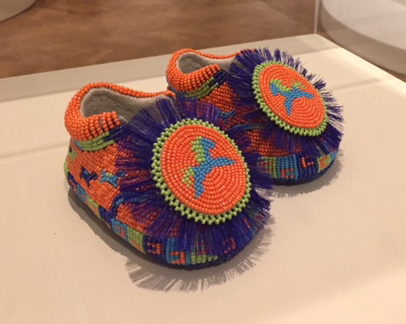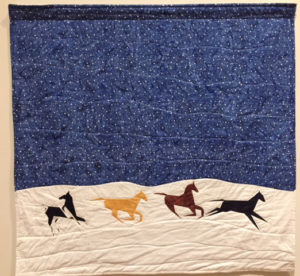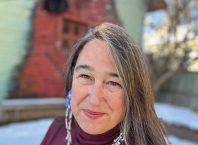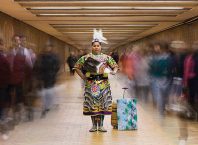By Deborah Locke
The idea for the Horse Nation of the Ochethi Sakowin exhibition originated with Lakota filmmaker and artist Keith BraveHeart. Below is an interview with Keith and several other artists included in the show. See Horse Nation article for a review of the exhibition.
KEITH BRAVEHEART
What is your personal connection with horses?
I grew up around horses on the Pine Ridge Reservation and had seen them as part of the landscape. My connection deepened while I lived on the Rosebud Reservation and worked with the Tiwahe Glu Kini Pi “Bringing the Family Back to Life” Program. This program provided services to support and encourage mental health wellbeing among children and families across the Rosebud reservation. A prominent successes of the program was it’s Lakota-based Equine Assisted Mental Health Therapy [or Equine Therapy]. I witnessed the horse bring transcendent healing to individuals and provide a healthy sense of cultural awareness.

That experience inspired me to create a documentary film that led to a journey covering the homelands of the Oceti Sakowin [Lakota, Nakota, and Dakota speaking tribal nations of the Northern Plains]. Over the span of five years, this Horse Nation journey has given me moments that are amazing and humbling. I am blessed to be a part of this journey and thank the Horse Nation (a Lakota philosophy and viewpoint that recognizes the horse as more than an animal but rather a relative) for all the beauty and understanding they have given me. So, my personal connection to horses is complex and I greatly appreciate and respect them.
How does your existence as a Lakota man influence your art?
As a Lakota, my identity greatly influences my art. I see myself as an artist, with a responsibility to use my gifts, opportunities, and privileges to amplify a marginalized voice and encourage cultural signification. It is my intention to create art, through whichever media, that reflects critical thought and supports contemporary action.
Why did you want both known artists and emerging artists in the show?
It is crucial that artists and those involved with the Native Art sphere reanalyze the way our arts and cultures are being defined. I feel once we gain opportunity to speak on our cultural signification, then we can demonstrate that our arts and cultures are not separated, that art and culture is one, it is life. With this philosophy, I felt that there shouldn’t be a hierarchy within our structure for the Horse Nation of the Ochethi Sakowin exhibition. If we were to honestly honor the Horse Nation, and share sincerely our expression, all must be welcomed and accepted. The identity of a Horse Nation of the Ochethi Sakowin is vast, and therefore it was also a must that we [curators] make all efforts to include the diversity among voices. I believe that as individuals with the opportunity to give, we had to be as inclusive as possible in creating positive moments.
What do you want viewers to take away from what they see?
I want viewers to first see that the horse is much more than only an animal. It is a dear relative to a huge confederacy of tribal nations. I want viewers to then recognize that our tribal nations are seeing their Horse Nation relatives through multiple perspectives, and that also reflects a multitude of contemporary realities. Our tribal nations do not only exist as artifact or only in historical context. We are contemporary, we are capable of contemporary thought and producing contemporary art.
–––––––––––––––––––––––––––––––––––––
GWEN WESTERMAN
Gwen Westerman, Sisseton/Wahpeton Dakota, is an artist and writer. Her striking quilt “Return to Crow Creek” is on exhibit at the Minneapolis Institute of Art “Horse Nation of the Oceti Sakowin” exhibit.

What do horses mean to you? When were you first aware of them? What stories did you hear about them from relatives? Did you ever ride one?
Yes, I have actually ridden horses, the first time was when I was seven years old. I have always loved horses. When I was in elementary school, the people who lived behind us had horses. I spent a lot of time at our back fence talking to those horses and feeding them apples from our trees. Near where I live now, there is a farm with miniature horses. Each spring, I wait for the foals to be born, and then love to watch “my” little horses grow and get strong and develop.
It’s hard to remember when I was first aware of them, but there’s something about their deep eyes, that soft muzzle, and their incredible strength that touches me at an innate level. They seem to sense who we are. I’ve heard relatives say that horses bear the burdens that are too heavy for us to bear – not just physical burdens, but spiritual burdens as well. That’s an incredible connection to think about whenever we see a horse or images of horses.
Where do you get your ideas for your art?
The women in my family have made functional quilts from fabric for at least six generations. My childhood was full of them. While many of the quilts I create are utilitarian as well, and I expect them to be used, they also tell a story. Lately, I have been focusing on using different techniques to portray a story by adapting some of the traditional patterns used in our family. I developed paper-piecing patterns for ledger-art style horses and buffalo, and now incorporate traditional beading techniques and other embellishments to create more dimensional quilts that recount our creation stories of the world, our people, and the animals that are an important part of our culture. My current work focuses on two themes: our connection to the land and the stories we tell through song. “Return to Crow Creek” is based on a story I heard from Peter Lengkeek of the Crow Creek Sioux Tribe. I’m always listening for stories, watching the landscape for ideas and color, and thinking about how to share that with others.
How does your heritage as a Dakota woman inform your art?
My uncle and my grandmother talked about how we need to tell the truth about our people and our history. I like to think that I do that in my art. As Dakota people, we have a long, rich history that explains not only where we came from, but also our responsibilities in this world to each other and to the universe. My art is grounded in Dakota culture and tradition, history, oral tradition, and language recovery – and the continuation of our story. When people see my work, I want these pieces to demonstrate there are many ways to present the contemporary interpretation of our traditional stories so they can be shared and preserved, including in quilts and textiles. A traditional story set in a quilt reaches audiences in another way when the art form includes fabric, as well as beadwork and painting in addition to a narrative.
When did you first notice that you had artistic ability?
Even though some of my earliest memories are of my grandmother making quilts by hand, I did not take it up until I was in my 40s, and certainly did not consider myself an “artist.” But I have been drawing and sewing and writing since I was a child. I can’t imagine my life now without art.
What medium are you most comfortable with?
I like to experiment. And since I focus first on story, the medium is secondary to my process. I dye my own fabric, paint on fabric, make conventional, “traditional” quilts, and mount some of my art quilts on stretcher bars like paintings on canvas. I’m also working on some clothing that incorporates traditional elements, which comes from my long experience of making my own clothes.
–––––––––––––––––––––––––––––––––––––
MARLENA MYLES
Marlena Myles, Spirit Lake Dakota, created the “Northern Lights’ Horse” digital vector on canvas in 2016. The woman represents the teachings of White Buffalo Calf Woman, who assists the Dakota during difficult times. Marlena wrote that as a little girl, she looked at the night sky and saw faint Northern Lights. Her cousin said that if they sang, the lights would dance. So the children sang and the lights danced.
Do horses mean something special to you? When did you first hear about them? Do they have an impact on you today and if so, what is it?
Horses don’t have a particularly special meaning to me as an individual since I grew up in an urban environment but I understand and realize they’ve meant a lot to my ancestors and relatives living today. Many of them have had and still maintain a special connection to their horses in a spiritual sense. I’ve come to appreciate the horse nation as I worked on this exhibition – they still help carry the prayers of the people.
How does your heritage inform you art?
My art is all about sharing my Dakota culture and continuing the tradition of telling our stories through the visual arts. Even though I create modern art using digital technology, I’m still maintaining a strong connection to the past so I can pass on those values to future generations after me.
How do you get ideas for your art?
Through stories of the people and history of the land, through Indigenous knowledge of our relationships between animal, plants and the natural cycles of the seasons. I’m starting to learn more about star knowledge and how what happens in the stars is reflected on Earth, or so they say.
When did you first realize that you had an ability to create? Did you ever draw or sketch as a child?
My grandmother used to send my sister and I art supplies and always encouraged us to be artists. My mom was a professional beadwork artist as well, so we were always surrounded by creativity.
The “Horse Nation” exhibit is in three locations with free admission at each location. See the art review for details.







